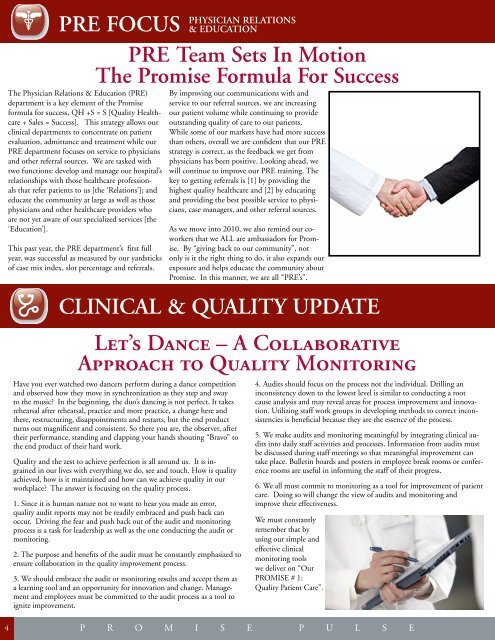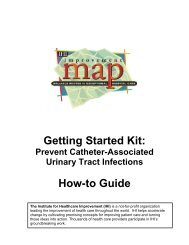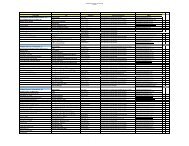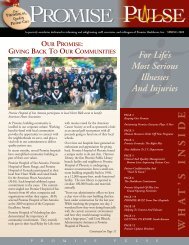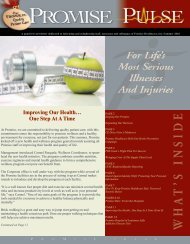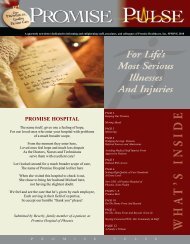Winter 2009/2010 - Promise Healthcare
Winter 2009/2010 - Promise Healthcare
Winter 2009/2010 - Promise Healthcare
You also want an ePaper? Increase the reach of your titles
YUMPU automatically turns print PDFs into web optimized ePapers that Google loves.
PHYSICIAN RELATIONS<br />
PRE FOCUS & EDUCATION<br />
PRE Team Sets In Motion<br />
The <strong>Promise</strong> Formula For Success<br />
The Physician Relations & Education (PRE)<br />
department is a key element of the <strong>Promise</strong><br />
formula for success, QH +S = S [Quality <strong>Healthcare</strong><br />
+ Sales = Success]. This strategy allows our<br />
clinical departments to concentrate on patient<br />
evaluation, admittance and treatment while our<br />
PRE department focuses on service to physicians<br />
and other referral sources. We are tasked with<br />
two functions: develop and manage our hospital’s<br />
relationships with those healthcare professionals<br />
that refer patients to us [the ‘Relations’]; and<br />
educate the community at large as well as those<br />
physicians and other healthcare providers who<br />
are not yet aware of our specialized services [the<br />
‘Education’].<br />
This past year, the PRE department’s first full<br />
year, was successful as measured by our yardsticks<br />
of case mix index, slot percentage and referrals.<br />
By improving our communications with and<br />
service to our referral sources, we are increasing<br />
our patient volume while continuing to provide<br />
outstanding quality of care to our patients.<br />
While some of our markets have had more success<br />
than others, overall we are confident that our PRE<br />
strategy is correct, as the feedback we get from<br />
physicians has been positive. Looking ahead, we<br />
will continue to improve our PRE training. The<br />
key to getting referrals is [1] by providing the<br />
highest quality healthcare and [2] by educating<br />
and providing the best possible service to physicians,<br />
case managers, and other referral sources.<br />
As we move into <strong>2010</strong>, we also remind our coworkers<br />
that we ALL are ambassadors for <strong>Promise</strong>.<br />
By “giving back to our community”, not<br />
only is it the right thing to do, it also expands our<br />
exposure and helps educate the community about<br />
<strong>Promise</strong>. In this manner, we are all “PRE’s”.<br />
CLINICAL & QUALITY UPDATE<br />
Let’s Dance – A Collaborative<br />
Approach to Quality Monitoring<br />
Have you ever watched two dancers perform during a dance competition<br />
and observed how they move in synchronization as they step and sway<br />
to the music? In the beginning, the duo’s dancing is not perfect. It takes<br />
rehearsal after rehearsal, practice and more practice, a change here and<br />
there, restructuring, disappointments and restarts, but the end product<br />
turns out magnificent and consistent. So there you are, the observer, after<br />
their performance, standing and clapping your hands shouting “Bravo” to<br />
the end product of their hard work.<br />
Quality and the zest to achieve perfection is all around us. It is ingrained<br />
in our lives with everything we do, see and touch. How is quality<br />
achieved, how is it maintained and how can we achieve quality in our<br />
workplace? The answer is focusing on the quality process.<br />
1. Since it is human nature not to want to hear you made an error,<br />
quality audit reports may not be readily embraced and push back can<br />
occur. Driving the fear and push back out of the audit and monitoring<br />
process is a task for leadership as well as the one conducting the audit or<br />
monitoring.<br />
2. The purpose and benefits of the audit must be constantly emphasized to<br />
ensure collaboration in the quality improvement process.<br />
3. We should embrace the audit or monitoring results and accept them as<br />
a learning tool and an opportunity for innovation and change. Management<br />
and employees must be committed to the audit process as a tool to<br />
ignite improvement.<br />
4. Audits should focus on the process not the individual. Drilling an<br />
inconsistency down to the lowest level is similar to conducting a root<br />
cause analysis and may reveal areas for process improvement and innovation.<br />
Utilizing staff work groups in developing methods to correct inconsistencies<br />
is beneficial because they are the essence of the process.<br />
5. We make audits and monitoring meaningful by integrating clinical audits<br />
into daily staff activities and processes. Information from audits must<br />
be discussed during staff meetings so that meaningful improvement can<br />
take place. Bulletin boards and posters in employee break rooms or conference<br />
rooms are useful in informing the staff of their progress.<br />
6. We all must commit to monitoring as a tool for improvement of patient<br />
care. Doing so will change the view of audits and monitoring and<br />
improve their effectiveness.<br />
We must constantly<br />
remember that by<br />
using our simple and<br />
effective clinical<br />
monitoring tools<br />
we deliver on “Our<br />
PROMISE # 1:<br />
Quality Patient Care”.<br />
4 P R O M I S E P U L S E


